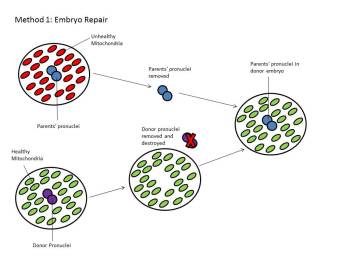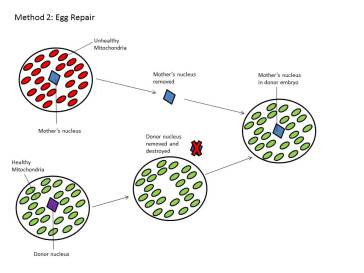The UK is likely to be the first country to allow the creation of babies via the three-person IVF technique but, what is three-person IVF and why is it necessary?
Why do we need three-person IVF?
Your body is made up of trillions of cells with each cell being specialised to perform a specific function. To do this cells need organelles, just as your whole body needs organs. One such organelle is a mitochondrion (plural mitochondria) which is often referred to as the power house of the cell as it is responsible for taking sugar from our food and converting it into energy.
This energy is created in the form of a molecule called ATP. ATP is vital for everything we need to do. We need it to breath, we need it to move and we even need it for our brain to function properly.
To be able to efficiently produce ATP mitochondria have their own genetic information which is passed down to the next generation via a mother’s egg cell. Mutations in these genes making it so that the mitochondria aren’t as proficient at producing ATP lead to mitochondrial diseases which are estimated to affect 1 in 6500 new born babies.
As mitochondria play a huge role in the cell you can imagine how devastating these diseases can be with symptoms including epilepsy, diabetes, deafness, blindness, muscle weakness and many more. Therefore, a woman who has a mitochondrial disease and wants to have children is faced with a massive dilemma.
Professor Doug Turnbull, director of the Wellcome Trust Centre for Mitochondrial Research, at Newcastle University, said: “Patients get progressively worse and many die so prevention is one of our priorities. Treatment is a long way off but, if we are able to use these techniques we can prevent these diseases now.”
How do you create a “three-person baby”?
There are two methods by which a “three-person baby” can be created: embryo repair and egg repair.

Diagram showing the method of embryo repair.
In embryo repair two embryos are created by fertilising both the mother’s and the donor’s egg cells. The pronuclei, containing the parents’ genetic information, are then removed from the embryos. The donor pronuclei are destroyed whilst the parents’ pronuclei are transferred into the donor embryo which can then develop into a child with healthy mitochondria.
Diagram showing the method of egg repair.
In egg repair the mother’s and the donor’s nuclei are removed from the egg cells. The mother’s nucleus is then transferred into the donor egg cell. This can then be fertilised using the father’s sperm to create a healthy embryo.
“Slippery slope”
A child born via three-person IVF will contain DNA from three people with donor DNA accounting for 0.1% of the overall genetic information. For some this is worrying as they feel that it could be the start of a “slippery slope” leading to the genetic engineering of babies and the start of a new eugenics.
In response to this Prof. Turnbull said: “This technique has been put through a rigorous process which started in 2010 and it is now 2014. It has been put through public consultation, ethical review and scientific review.” He also added that he did not “want to go down a slippery slope” and to avoid this it was being looked at carefully.
Is it safe?
There is still the question of safety to answer. Prof. Turnbull said: “Anything first into man has got to be a risk. What we must always remember and weigh up is the risks of a woman having an unhealthy child.”
So far the three-person IVF technique in rodents and primates has had “very positive outcomes” however, there are still some hurdles to overcome. Embryos made using this technique need to be assessed to check they develop normally. Moreover, the technique is yet to be tested to check it is efficient as if only 1 embryo out of 100 survives this technique will not be considered “good enough.”
When will three-person IVF be licensed in the UK?
Work is ongoing to get three-person IVF licensed to be carried out in the UK however, there are still a couple of procedures to go through before this can happen. The first is that three-person IVF needs to be approved by UK parliament. Secondly, any unit that wishes to carry out three-person IVF needs a license from the Human Fertilisation and Embryology Authority (HFEA) to make sure it is as safe as can be.
Considering all these factors Prof. Turnbull said: “one can hope that this technique will be feasible in the next couple of years.”
